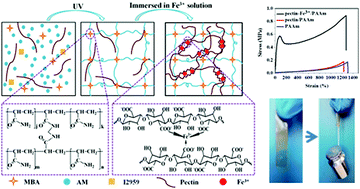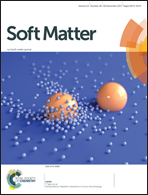Hybrid pectin–Fe3+/polyacrylamide double network hydrogels with excellent strength, high stiffness, superior toughness and notch-insensitivity†
Abstract
The lack of sufficient mechanical properties restricts the application of polysaccharide-based hydrogels in the field of biomedicine, especially load-bearing tissue repair. Nowadays, double network (DN) hydrogels have aroused great interest through special cooperation between two contrasting networks. Inspired by this idea, here, we devised a new strategy to prepare a pectin–Fe3+/polyacrylamide hybrid DN hydrogel using a simple two-step method. The introduction of Fe3+ ions into a pectin network to produce strong reversible ionic complexation, results in excellent toughness. Under optimal conditions, our hybrid DN hydrogels possessed tensile strength as high as 0.9 MPa, corresponding to a high strain of 1300%. Besides, our hybrid DN hydrogels also exhibited superb stiffness (elastic modulus ∼ 1.46 MPa), toughness (fracture energy ∼ 3785 J m−2), and water absorption capacity (85%). Loading–unloading tests showed that the internal fracture process of the hydrogels was continuous. Owing to the reversible structure of Fe3+–pectin complexation, the hybrid DN hydrogels also showed good fatigue resistance, notch-insensitivity and recoverability. This type of polysaccharide-based hydrogel has potential to broaden the application in the load-bearing tissue repair field.



 Please wait while we load your content...
Please wait while we load your content...